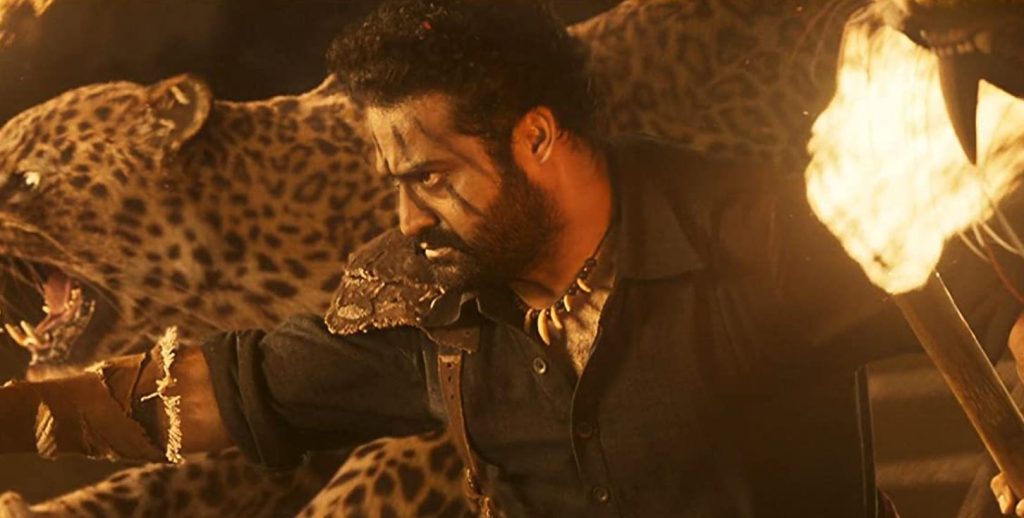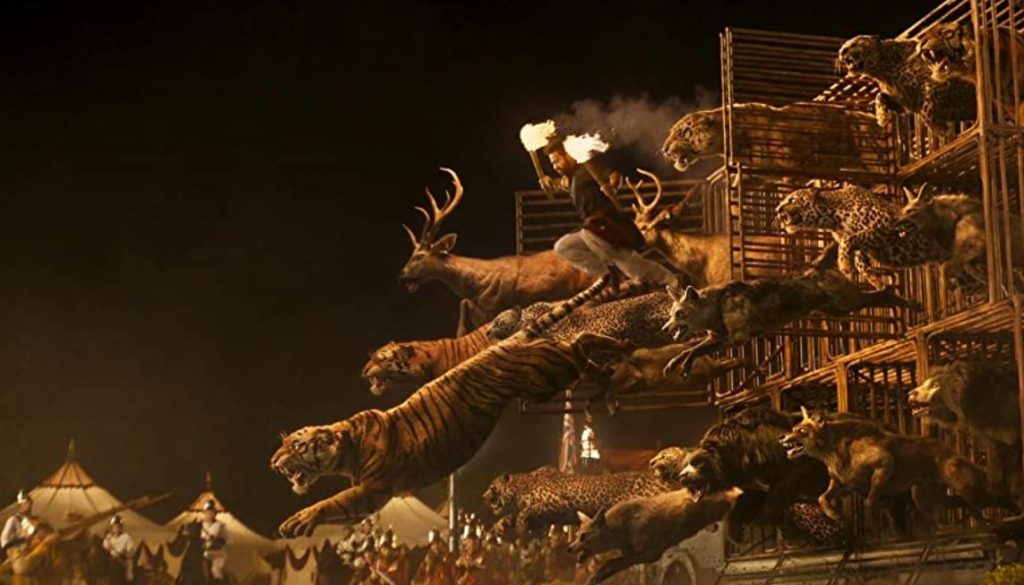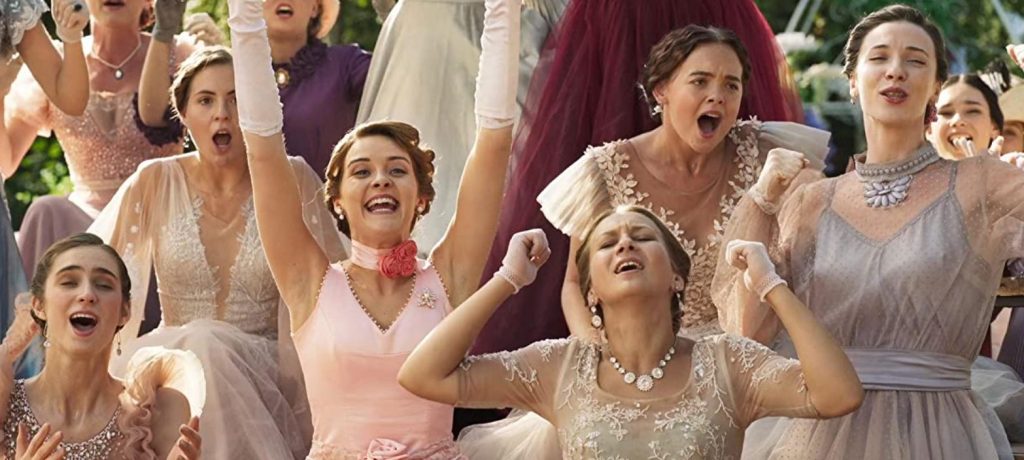It is nearly impossible to begin describing the relentlessly entertaining over-the-top Indian historical action epic RRR (Rise Roar Revolt), so let’s begin roughly where the movie does, with the introductions of its two lead characters. Based on real Indian revolutionaries from the early 20th century, each is given an entrance that an average action movie would be lucky to have as its climactic set piece, and their superhuman feats of awesomeness, separately and together, only grow more impressive and insane through the remainder of RRR‘s three-hour runtime.
Alluri Sitarama Raju (Ram Charan Teja) is introduced in uniform as a soldier for the Indian Imperial Police. Given the order to arrest one particular man in a sea of thousands of rioters, he singlehandedly fights through the crowd, all of whom are intent on beating him to a jelly, and brings the man back at great physical injury to himself, prompting the British commanding officer to say, “I’m more afraid of him” than the rioting mob. It is one of the most convincing and coherent epic fight scenes ever filmed, and it is just an introduction to Raju, highlighting his incredible fighting technique and stubborn refusal to give up against insurmountable odds.

Komaram Bheem (N.T. Rama Rao Jr.), Raju’s soon-to-be dear friend/deadly antagonist is introduced outwitting and outrunning first a wolf and then a tiger, before demonstrating his equal if not greater strength against the tiger in an electrifying sequence that expertly blends real-life action choreography with gorgeous computer-generated imagery. This is just the first of the movie’s incredible animal-based set pieces; as seen in Raju’s intro, RRR sets the bar for hyperkinetic action scenes high and continually raises it.
A pair of heroes so superhumanly awesome as this deserves a great villain, and while they spend much of the movie as one another’s antagonists, the true villain is none other than the big screen’s greatest Punisher, Ray Stevenson, as British Raj administrator Scott Buxton, who along with his equally odious wife, Catherine (Alison Doody), forcibly buys a child, Malli (Twinkle Sharma), from her unwilling family in Bheem’s tribe. Stevenson brings every ounce of the considerable malevolence in his possession to the performance, and Doody matches his extreme hatefulness to the fullest, resulting in two of the most hissable villains imaginable.
This incident sets off the story, as Bheem is enlisted to go undercover in order to find Malli and bring her back, and Raju, determined to become a special officer in the Imperial Police for reasons of his own, is enlisted to go undercover and stop Bheem. When the two heroes, neither knowing who the other really is, rescue a small child after a train explosion (another bravura action scene), they become fast friends by virtue of all they have in common as men of action and utter bad-asses. So, then they have a lengthy friendship montage to celebrate their mutual badassery, complete with a piggyback ride and a friendship song that is undoubtedly even funnier and more delightful in translation than in its original language.

American audiences unfamiliar with the Indian Telugu-language cinema known as “Tollywood” (a riff on the somewhat more internationally known “Bollywood,” its Hindi-language equivalent) might not know what to make of the shifts from insane action to full-on musical sequences, but the brilliance of RRR is that it blends these seemingly disparate styles as seamlessly as the stunt work and CGI in the action sequences. The aesthetic of the movie is so meticulously realized that crowd-pleasing dance numbers can coexist with brutal violence and the shifts never feel jarring. Everything is pitched at an operatic level of intensity even when the scene is not actually a musical one (there are really only a few, even including the traditional closing number), and the sight of the same two brilliant performers making meals of both action and dance numbers underscores how much the two types of performance have in common.
It cannot be overstated just how charming and excellent Teja and Rao are in the lead roles, but the movie would not be so amazing and unique without the vision of its director, S.S. Rajamouli. A list of his ten favorite films published in Sight & Sound is comprised, with only one exception (Mayabazar, which stars Rao’s father), of epic Hollywood movies, including three animated features (Kung Fu Panda, Aladdin, and The Lion King). RRR certainly deals with the same heightened emotions, not to mention superhuman abilities to heal from injury, as the great cartoon characters, though the stakes are grounded in real history here.
Among the rest of Rajamouli’s choices, we can also see the influences on RRR in historical epics like Ben-Hur, Braveheart, Apocalypto, and Django Unchained. In all of these examples, particularly Tarantino’s extreme revisionist history (of which Inglourious Basterds and Once Upon a Time in Hollywood complete the spiritual trilogy), we can see a kind of reverent irreverence for the actual historical account. In Tarantino’s work as well as RRR, we see a revision of the classic “print the legend” philosophy: make up your own legend and print that in bright, bloody colors across the biggest canvas possible.

This blurring of the lines between true history and fantastical nonsense is also found in his other two picks, Forrest Gump and Raiders of the Lost Ark. The former of these shares Rajamouli’s embrace of CGI technology in order to achieve the formerly impossible (though Gump‘s effects look less impressive today), and of course Raiders showcases the same love of big action set pieces and irresistible desire to entertain from start to finish.
Despite these apparent influences and the ways in which RRR employs various familiar tropes and themes, such as the “friends on opposite sides of the law” plot of so many action movies (Point Break comes to mind, as well as Infernal Affairs and its Hollywood remake, The Departed), it always manages to make even the most familiar feel fresh and original. For fans of action movies especially, this musical superhero bromance revolutionary historical war epic is an absolute must-see, but also for anyone who enjoys exhilarating cinema in general.